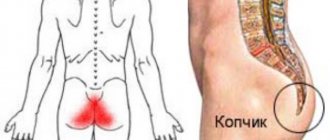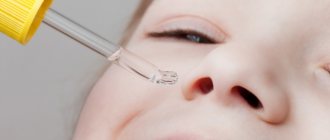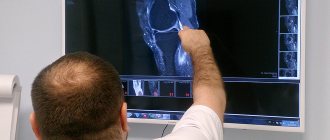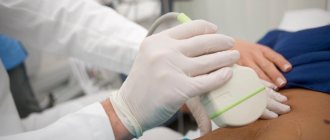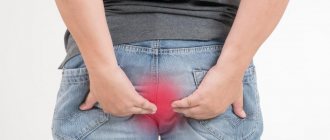Aching, sharp, sudden or constant pain in the tailbone is a problem with which people regularly consult a neurologist
. Discomfort in this area can occur for a variety of reasons, and most often it is only noticed when the pain becomes constant (for example, when pain appears and does not go away when sitting or standing). Constant, incessant pain may indicate a serious illness, and not a simple bruise, the pain after which goes away for some time after the treatment prescribed by the doctor. As a rule, problems with the tailbone are more often diagnosed in those who lead a sedentary lifestyle, but there are other reasons.
Anatomy of the coccyx and coccygeal-sacral joint
The coccyx is the trailing, lowest part of the spine. The coccyx is a rudimentary part of the spinal column; it is formed from 3–5 fused vertebrae, each of which has a rudimentary body, transverse processes and joints. The shape of the coccyx is a small triangle or pyramid, which is inverted with the narrow part down. The sacrum is the penultimate section of the spine, which is connected to the coccyx by the sacrococcygeal joint (joint). There are differences between the male and female coccyx and the mobility in the area of the connection with the sacrum. The male coccyx has a curved shape, and, as a rule, it is motionless at the intersection with the sacrum. The female tailbone is not as curved and more mobile, that is, it can deviate towards the back. This physiological feature is necessary for a woman to give birth and for a child to pass through the birth canal.
Despite the fact that the coccyx is considered a vestigial remnant of the human tail and a seemingly unnecessary organ, its presence is nevertheless important:
- The coccyx is the junction of a large number of nerve endings, muscles, ligaments and tendons, which are necessary for the normal functioning of the organs of the genitourinary system and colon;
- the gluteus maximus muscle is attached to the coccyx;
- the nerve endings attached to the anterior surface of the coccyx are connected to the pelvic organs;
- The tailbone serves as an additional support point for a person when he bends back and forth - in this case, the tailbone is responsible for evenly distributing the load on the pelvic part of the spine.
Any injuries and pathologies of the coccyx lead to pain and require professional medical care.
Causes of pain in the tailbone
If you go to the doctor and say that your tailbone hurts, the first thing he will ask is whether you have had any injuries. Injury to the lower back is one of the main factors in the occurrence of pain in the tailbone. Discomfort in the coccyx area is divided into two types:
- Coccydynia – when a patient comes with a complaint, and after diagnosis it turns out that the problem lies in the coccyx itself.
- Anorectal pain - when pain is associated not with the tailbone itself, but with diseases and pathologies in the body (scars after operations, inflammation, disorders of the gastrointestinal tract and genitourinary system), but the patient complains of discomfort specifically in the area of the tailbone.
The specialist’s task is to find out what the problem is related to - an injury specifically to the coccyx or to any diseases. The course of treatment will depend on why the tailbone is sick.
Tailbone injury
Coccyx injuries include fractures, bruises, dislocations, cracks and displacements that occur due to unsuccessful falls, blows to the buttocks and accidents. The pain is strong, sharp and sharp. After the first attack, it subsides, but depending on the complexity of the injury, it can have a constant aching character or make itself felt periodically. The tailbone can also be injured in the following cases:
- during childbirth;
- when performing heavy physical work, when the body is constantly extended and flexed;
- with the habit of constantly sitting on upholstered furniture;
- while playing sports.
Local pain can occur both in the tailbone itself and near it. Often pain after an injury occurs immediately, and sometimes it comes with some delay. In any case, you should immediately consult a doctor.
Coccyx cyst
The cyst is formed not in the coccyx itself, but in the coccygeal-sacral joint, and is very often diagnosed in men (aged 15 to 30 years) who come for a consultation with a specialist complaining of pain in the coccyx or below. As a rule, a cyst is a congenital neoplasm located in the middle of the gluteal muscle. For a long time, the cyst may not bother you in any way, but with provoking factors, the process of suppuration usually begins, which causes the growth of the cyst and the appearance of pain. Treatment in this case is only surgical, followed by a course of rehabilitation. Another reason why men have a sore tailbone is “jeep disease” (due to long driving on tractors, tanks and other vehicles without springs). With such a load on the pelvic area, inflammation often occurs in or near the tailbone, which also causes the appearance of a cyst.
Osteochondrosis
With osteochondrosis (degenerative development of articular cartilage and intervertebral discs), a person complains of pain in the coccyx, which radiates to the sacrum and lower back. In this case, discomfort is felt during movement, in an awkwardly occupied position and during prolonged sitting. Pain can also radiate to the pelvic organs and legs.
Neurological diseases
Neurological diseases that lead to painful discomfort in the tailbone include pinched nerves (sciatic or lumbar). A person experiences a sharp pain with an uncertain location, that is, it can radiate to the lower back and sacrum.
Indications for coccyx blockade
Injections of medications into the spine are prescribed if other conservative treatment methods, such as medications and physical therapy, are ineffective. With their help, it is possible to interrupt the pathological nerve conduction of the pinched areas, thereby relieving the patient of chronic pain.
Kazieva Aminat Ziyavovna
Neurologist
Rostov State Medical University
Experience since 2012
If desired, a coccyx block can be completed at a medical clinic. The main indication for the procedure is the treatment of coccydynia.
Features of pain in this disease:
- dull, aching, bursting or pulling, in severe cases the pain is burning, sharp;
- accompanied by pressure and a feeling of heaviness in the lumbar region;
- pain radiating to the perineum, buttocks, sacrum, rectum;
- worsens in a sitting position, after rising from a chair, during physical activity, constipation, can occur during sexual intercourse, coughing, sneezing;
- decrease while walking, after defecation.
Soreness is not the only symptom of coccydynia. Due to constant pain, a person becomes more careful in his movements and tries to sit on a chair so as to experience the least discomfort. The patient sits on one buttock, thereby moving the body weight to one side. As a result, muscle overstrain occurs, curvature of the spine and joint deformation are likely.
This is how a patient with coccydynia sits
Constant severe pain provokes nervous tension, sleep problems, leads to rapid fatigue, and the development of irritable bowel syndrome. They cause deterioration in physical and psycho-emotional condition.
Relieving the patient of constant debilitating pain and returning him to normal life is the main goal of the neurologists at the SmartMed clinic. It is important to understand that coccydynia is a chronic disease, so its treatment requires a professional approach.
Treatment for pain in the tailbone
The first step in treating the tailbone is determining the cause. To do this, the doctor at the initial consultation examines the patient (palpation diagnostics) and collects complete information about the state of health and the causes that led to the onset of pain. Next, the patient is prescribed the following examinations:
- X-ray
– helps to diagnose intervertebral hernias, osteochondrosis, curvatures, fractures and displacements, etc.; - myelography – prescribed to identify spinal hernias (during the procedure, a contrast agent is injected into the spinal canal);
- and MRI
- for diagnosing many diseases of the spine; - urological and gynecological examinations;
- blood test (if necessary).
After the doctor determines why the tailbone hurts, he decides what to do and draws up a treatment plan.
Drug treatment
Drug treatment is aimed at relieving pain and inflammation. Nonsteroidal anti-inflammatory drugs are prescribed, which are often administered in the form of suppositories or microenemas. For severe pain, painkillers may be prescribed to block the area where the pain is most severe.
Physiotherapy
As a rule, this is shock wave therapy, which involves the impact of acoustic waves on the tailbone and nearby tissues. Ultrasound therapy allows you to destroy salt deposits, eliminate various congestion and promote the resorption of postoperative scars. Often prescribed to women in labor and people who have suffered trauma. Physiotherapy methods for discomfort in the tailbone also include ultrasound treatment, darsonval, therapeutic mud and wraps, laser therapy, diadynamic currents, etc.
Massage
Massage, as well as physical therapy and manual therapy, is often prescribed to patients whose coccyx pain is caused by osteochondrosis and there is poor circulation in the lower back. Finger massage of the pelvic floor and rectal muscles relieves spasms and significantly relieves pain. Manual therapy can improve blood circulation, remove blood stagnation and restore the mobility of the tailbone.
Acupuncture
Acupuncture, or acupuncture, is prescribed to reduce the intensity of pain. Procedures are prescribed for patients with osteochondrosis. The number of procedures and points for placing needles is determined by a specialist depending on the situation.
Diagnosis of coccydynia
Coccygeal pain syndrome is difficult to diagnose. Since the pain radiates to the rectum and genitals, gynecologists and proctologists may be involved in the examination, who help to exclude or confirm diseases of these organs.
But the main specialist who diagnoses and treats coccydynia is a neurologist. The doctor makes a diagnosis based on the collected history, physical examination and instrumental examination.
At the initial appointment, the neurologist clarifies the nature of the pain, asks about injuries, falls on the tailbone, and surgical interventions in the pelvis. The doctor studies the patient’s medical history, then proceeds to examine and palpate the spine, in particular the sacrococcygeal region.
Note! With coccydynia, palpation is painful. If there is no pain when pressing on the tailbone, then the pain is associated with osteochondrosis, a herniated intervertebral disc or other pathology.
Mandatory diagnostic procedures include a rectal digital examination, which is performed by a proctologist in order to assess the condition of the pelvic muscles and the presence of overstrain.
To determine the cause of coccydynia, the doctor prescribes the following examination methods:
- Ultrasound of the pelvic organs;
- colonoscopy;
- X-ray, CT or MRI of the spine.
Of the instrumental methods, MRI is the most informative. With its help, you can detect post-traumatic changes, tumor neoplasms, and organic disorders. You can get an MRI at the medical office. The clinic has installed a new ultra-precise MRI scanner.
If necessary, create a 3D model of the area under study
The diagnosis is known on the day of diagnosis. After an MRI, additional examination is often not required, since the cause of pain and its etiology can be detected. Treatment is prescribed by the attending physician, referring to the diagnostic results.
Kazieva Aminat Ziyavovna
Neurologist
Rostov State Medical University
Experience since 2012
Prevention of pain in the tailbone
The main preventive measure in the fight against coccyx diseases is the correct posture when sitting, working on your posture; It is also not recommended to abuse sitting on upholstered furniture, placing pillows and poufs. With such factors, there is a serious risk of developing osteochondrosis and worsening existing diseases. It is also not recommended to wear clothes that compress the waist and waist area; it is highly advisable for pregnant women to wear a support bandage, which avoids deformation of the tailbone. Among other things, doctors recommend regular exercise, strengthening the muscle corset and muscles around the spinal column, and monitoring nutrition.
